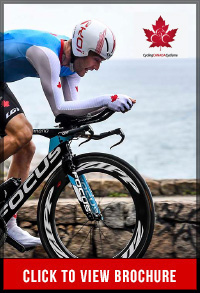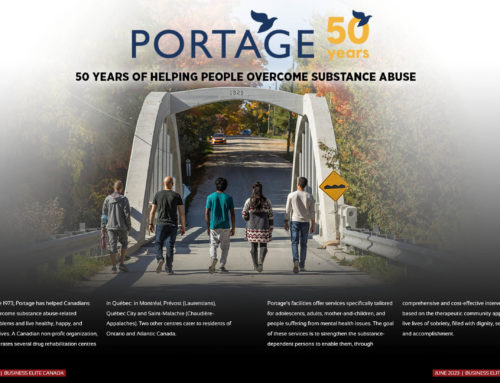It’s a telling and elucidating moment when the CEO of Cycling Canada himself says his favourite thing about cycling is the freedom and independence the sport brings with it. Beyond the podium and glory, cycling is a sport that anyone can enjoy.
The organization is on a mission to reignite Canadians’ passion for cycling, in any of its forms. There is a cycling discipline for everyone, and Cycling Canada represents them all, including BMX, Cyclo-Cross, Mountain Bike, Para-cycling, Road, and Track. “The one thing that all disciplines have in common is it begins with the freedom to explore,” says Lafontaine.
Pierre Lafontaine joined Cycling Canada in late 2016 as CEO and Secretary General as part of the organization’s new, energized strategic focus on elevating the sport in Canada. One of Canada’s most distinguished sport leaders, Lafontaine brings a wealth of international and national experience to the cycling community, having served as a leader in various federations of Canadian sports (Cross Country Ski de Fond Canada and Swimming Canada, for example).
Tasked with “leading [Cycling Canada’s] exceptional staff towards realizing the vision of being a leading cycling nation by 2020, Cycling Canada is developing a plan designed to increase participation in the sport and, ultimately, put more Canadian cyclists on the Olympic and Paralympic podiums.
Cycling Canada uses a national cycling strategy to promote cycling in Canada. The organization’s focus on recreational and competitive cycling is not mutually exclusive; the more exposure the sport gets on a community level, the greater the interest in competitive levels.
High Performance
In 2008, Cycling Canada conducted a 360-degree review of its high performance program, focused on the 2020 Olympics and Paralympics. Technical leadership was a big focus—Cycling Canada has gone from one full-time coach in 2009 to 11—as well as grassroots, community initiatives to introduce and reintroduce cycling back to Canadians.
The new direction is already reaping rewards, with big results at international competitions and nine Paralympic medals and two Olympic medals in Rio. “These performances don’t happen by chance,” says Jacques Landry, Chief Technical Officer and Head Coach. “They happen with planning and implementation. We recently strengthened our coaching staff with international and domestic coaches that provide a robust coaching system for better service support to the athletes, and in turn they put in great performances.”
Canada also has an extremely strong foundation of Junior riders. “I remember being awestruck by the number of talented Junior, U17 and U18 track cyclists at the 2014 Nationals,” says Landry, “and the number of riders has doubled since then.”
“Our goal is to ensure cycling remains a powerhouse well into the future, to provide the tools our athletes and coaches require to be world-leaders from the grassroots to elite levels, and to make the sport one of the premier activities in all corners of the country,” says Lafontaine.
Alignment with Provincial Partners
Creating fluid partnerships with the provincial cycling bodies will be a huge component to achieving Cycling Canada’s vision, says Lafontaine. “Reaching out to the provinces, defining our partnerships with stakeholders (such as Own the Podium, the Canadian Olympic/Paralympic Committees and key private sector partners), and implementing items from our strategic plan serves to strengthen our relationship with the provinces and, therefore, our events and programs with each,” says Lafontaine. “Part of the work we do is to build a streamlined and seamless pathway between what the provincial bodies do, and what we do, whether in competition, coaching development, or community events.”
Of course, in a country the size of Canada, each province has a unique set of realities and mode of operating; gaining an understanding of these is key to creating beneficial and long-lasting relationships with the provinces. “Understanding how each province operates is a huge focus for us,” says Lafontaine. “We must understand every organization in order to design the best and most effective plans for the provinces in regards to getting more kids on bikes.”
By creating a coordinated policy and matching it with proper funding at the highest level, Canada is positioned to be a country of bike riders.
Community Engagement
“I want this organization to be thought of as Cycling in Canada, not just Cycling Canada,” says Lafontaine.
An important objective on the part of Cycling Canada is to get more Canadians enjoying recreational cycling as an introduction to the sport. Lafontaine says that while road cycling is the most visible and high profile discipline, cycling in all forms is undoubtedly on the rise. “Road cycling has long been considered the new golf,” he says.
Cycling is unique in that it can be recreational, competitive, or a mode of transportation integrated into a healthy lifestyle. Over 200,000 Canadians bike to work each day (according to Canada’ national household survey), and with increased infrastructure like bike lanes, that number is increasing, particularly in urban settings—after all, 20 bicycles can be parked in the same space as one car.
Events like the Seventh Annual Bike Day on the Hill, taking place on June 1st, raise the sport’s profile and remind Canadians of the benefits of riding to work, which are all encompassing: it is free, better for the environment, often faster than a vehicle, and healthier.
When you consider that less than 10 per cent of 5 to 17-year-olds in Canada meet the recommended amount of daily exercise, and only two per cent of children in Canada bike to school (extremely low compared to parts of Europe with similar climate), it becomes more than clear that there is a significant opportunity to affect change and have an impact on the health and wellbeing of the nation.
Corporate Support
Cycling Canada relies on strong private sector partnerships as a key factor to its success. Global Relay, a Vancouver-based leader in the IT sector, led the charge from Canada’s corporate community, signing on as Cycling Canada’s Premier Partner in 2014. The company has provided vital funding and support for Canada’s elite and emerging athletes as well as a variety of events both locally (The Global Relay Gastown Grand Prix) and at the national level.
Mattamy Homes’ significant contribution to Canada’s cycling community has also been a game changer on a number of levels. The Mattamy National Cycling Centre velodrome, the only facility of its kind in Canada, and only the second in North America, is a symbol of increasing participation in cycling in this country. Working in close harmony with Cycling Canada, the facility cultivates world-class Canadian cyclists and local enthusiasts alike. The facility was built in 2015 for the Toronto PanAm and ParaPanAm Games with significant private funding from Mattamy as well as a number of private donors. Mattamy followed-up its investment in the velodrome with a sponsorship commitment supporting Canada’s National Track Cycling Team.
Private sector support for the sport has continued to grow with ECOASIS (Bear Mountain Resort) and Lexus Canada announcing major long-term commitments to cycling in 2015 and 2016, respectively. Over the past year Lexus’ high performance vehicles have become an integral element of almost every major competitive cycling event in the country.
Cycling Canada’s family of performance partners also includes a who’s who of Canadian-based leaders in the global cycling and high performance sport industries. Suppliers such as Louis Garneau (apparel), [Argon 18] (bikes), Alphamantis (aerodynamic research), Thought Technology (biofeedback), Swagman (roof racks) and Blade Carbon Wheels provide world class products and technical support to Canada’s National Team and high performance development programs. “Technology plays such a big role in determining success in the world of elite cycling,” notes Landry. “We are fortunate to have some of the world’s most innovative industry partners right here in Canada supporting our programs. Our athletes are made in Canada and so is the bulk of our equipment—not a lot of countries can say that.”
To learn more about Cycling Canada and events close to you, please visit www.cyclingcanada.ca







